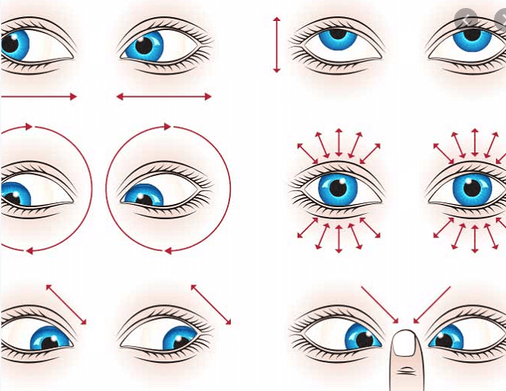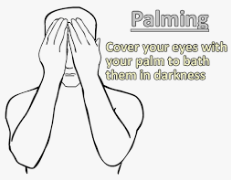*Article en Français – Clickez ici*
Human vision performs very well compared to other species. Humans can see both near and far, day and night, 2D & 3D and are sensitive to colors and contrasts. Our vision is generalist and efficient. However, in the modern world (city life, use of screens, pollution, etc.), our eyes are both misused (we mainly use them for near vision, especially on a screen) and overused since they are often used instead of the other senses. They therefore suffer from eye fatigue and various disorders. Human vision is becoming more and more “specialist” and less and less efficient. This is how Yoga for the eyes has become a need of the modern world.
YOGA FOR THE EYES
It is the research of Doctor Bates, famous American ophthalmologist of the beginning of the XXth century which establishes for the first time in the world of Western medicine a very clear and very strong link between the good health of the body in general and the good health of the eyes. . Today it is an established fact that certain diseases such as diabetes for example or diseases of the liver and gallbladder have a direct impact on the quality of vision. Likewise, high blood pressure will often cause eye problems. It therefore seems obvious that vision disorders cannot be treated without taking into account the health of the person as a whole.
In the Indian culture with Ayurveda and in traditional Chinese medicine, this has always been established fact, Indeed, an holistic approach the human beings is fundamental for both of these traditional and ancestral health systems.
Thanks to a set of practices and lifestyle habits, yoga, and more specifically yoga of the eyes, offers concrete and varied solutions to improve vision.
PROMOTE THE CIRCULATION OF ENERGY IN THE BODY
Regular practice of yoga and prānayama improves the circulation of energy flows in the body and eliminates or reduces certain blockages. Yoga for the eyes features mainly postures that aim to smoothen and promote mobility in the cervical spine such as for example bhujangāsana or cakravākasana (often in modified forms) or simple movements of the arms (standing or lying down) for example.
The technique of nadi-śodana or alternating nostril breathing is also often beneficial (except of course if you have a stuffy nose). It is balancing and stimulating at the same time.
CULTIVATE GROUNDING AND BALANCE
By cultivating grounding and balance. To see properly, you need a stable base where the energy flows well. In a way, our eyes are the lens of the camera and the body is the foot. For the image to be good, the optics must be in good working order and the foot must be stable!
REDUCE STRESS
Stress is often responsible for the degradation of our energy level. It is known that a strong emotion that involves a significant rise in stress, such as bereavement, moving house or even “professional burnout”, frequently causes a sudden drop in vision. Channeling your stress and emotions therefore greatly contributes to improving your vision. Here again, Yoga and Meditation are powerful allies.
REDUCE TOXINS IN YOUR BODY
It starts of course with a healthy lifestyle and a good diet. The less toxins there are in the body, the easier it is to eliminate them. But there are times when there is no choice. I am thinking in particular of heavy medical treatments where the patient is forced to ingest and digest and eliminate a large amount of toxic substances. Yoga offers a wide range of detoxification techniques both through postures, breathing exercises, but also mantras or visualization (meditative practices) that help the body and mind to eliminate more effectively.
More specifically, Ayurveda offers eye massages in the form of a “Ghee bath” which aim to promote detoxification.
DO BOTH: MOBILIZE AND RELAX THE EYES
At last, yoga for the eyes offers a whole range of eye mobility and relaxation exercises, very playful and very varied, which allow the different eye muscles to work.
- Work eye focus:
In the modern context, the eye is used to seeing up close (screen, screen and… screen). We are losing our ability to see far and above all to adapt quickly. The first exercise that I propose to you is to fix a point in the distance. Ideally a tree or something far from you outside. When it is in focus, stare at an object near you. When it is in focus, return to the object in the distance. And so on as quickly as possible. Ideally, do this every 30 minutes if you are working on a computer. Ball and ball games are also great for this!
- Engage your eyes muscles!

Laterally. Look to the right and then to the left quickly several times Eyes open then eyes closed. Same thing from top to bottom then diagonally. Warning! It is important to take a break between each exercise. The best is to practice the technique of palming between each exercise (see below).
- Coordination & strengthening of your eyes muscles:
Arms outstretched in front of you, eyes open. Move the left thumb / arm to the side and follow with your gaze. Same thing when coming back. Then close your eyes. Move your thumb in the same way and “follow with your gaze” the darkened eyes. At the end, open your eyes. Do the same on the way back and then the same on the other side. It is an interesting exercise that promotes both the mechanical and the cognitive aspect.

- Meditation on a candle flame
Sit in your meditation posture (on the floor or with supports) with your back straight and a firm seat. Stare at the candle for at least 5 minutes (more if possible, there is no limit). Let yourself come into osmosis with this source of light. The flame of the candle is a light that does not burn the eyes. This practice allows you to relax the eyes and go beyond just working on the vision.
- Palming
This is one of the most famous eye yoga exercises and was already prescribed by Dr Bates. It consists of putting the two hands in the shape of a shell on the closed eyes, making sure that the light does not pass.

In conclusion, I would say through the yoga of the eyes it is also the development of a certain inner gaze that is established. The workshops that I offer give you a good introduction to this surprisingly vast subject, and avenues of understanding and proposals to improve your vision. However, it is up to each one to continue or not his research towards an interior look. You can obviously contact me for individual yoga therapy sessions in Lisbon, Paris or my yoga & meditation retreats in Portugal. I am also available via Zoom for online sessions.
Céline Chambat
Yoga Teacher & Therapist

